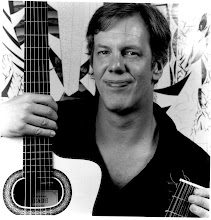 Brazil is a tune forever associated by most people, especially those tuned into gypsy jazz, as one of Django Reinhardt's finest moments. The tune was also used as the title track in the Terry Gilliam film of the same name.
Brazil is a tune forever associated by most people, especially those tuned into gypsy jazz, as one of Django Reinhardt's finest moments. The tune was also used as the title track in the Terry Gilliam film of the same name.Brazil, Django Reinhardt
Playing Brazil
The most compelling feature of the music is the unrestrained enthusiasm and its unabashed Latin quality of the piece, though the underlying rhythm does not fit into the basic established patterns of the rumba, tango, or samba. The melody itself is a 'rift' tune in the Swing style, and the Latin feel is created in the head to a large degree by the highly-syncopated secondary chromatic melody from the fifth of the scale to the seventh and back again to the fifth. Hence, the song, at least the head, features not one rift, but two!
Included at the right side of the page is the score of the head. Since there are two independent melodies that run through most of the head, the piece is, at the minimum, a duet, and it is as a guitar duet that the score has been arranged.
The chord symbols are also given over the score, so the melody in the higher part of each paired system and the chords above may be used as a fake book score by a band. Here the secondary melody in the highest voice of the lower part of the system must be played by second player, but the remaining parts of the texture can be filled out by the comping instrument, bass, and drums in the standard way.
To view the score in right column of the article, right click, open in a new window and, to save the score to your computer, right click a second time.
I play with pick-up bands but have no regular gig, and sometimes I play social functions (restaurants, wedding and corporate cocktail hours, private parties, etc.) solo. When I do, I use rhythm tracks that I have made and drive them through my amp from my laptop. I also use rhythm tracks to sharpen my improvisational skills when practicing at home. I have provided two videos, one of me improvising to one of these rhythm tracks and a video for your use for practice that features the second guitar part as written on the score above.
The audio given on the practice video below is slower than the version I use in my improvisation below and my version crawls compared to Reinhardt's, but the practice video is fast enough to be useful in learning your way around the song. The file goes on for four complete stanzas, so there is time to both practice the head and sharpen your skills at improvising. The progression is simple: G and D7 in alternation (major, mixolydian from tonic, major pentatonic, and even minor pentatonic)-E7 (major phrygian, diminished, alt scale)-Am9 (A pentatonic, natural minor, dorian, melodic minor, E major phryrgian continued from E7)-D7 (all the same scales the song started with over the tonic chord pus mixolydian on D and even materials from the diminished chord or scale). The rate of harmonic change is very slow, so there's time to explore! Have fun!
Last, here is my take on Brazil using a slightly modified version of the rhythm track (faster and with bass added). If you decide to use this song in a band setting, once past the head, I would recommend abandoning the secondary melody, as does Django, and add momentum through the use of a walking bass.
Brazil (my version)

No comments:
Post a Comment